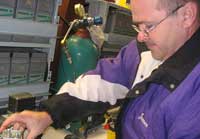
Strizki: hydrolise me.
The land around Mike Strizki’s Colonial house in New Jersey is lush and messy — a half-dozen cars and trucks, a boat and farm equipment are parked in various places. Stritzki himself is an overweight workaholic, and an unlikely hero for the Peak Oil movement. But a sign at the start of the long driveway welcomes visitors to the “1st solar-hydrogen residence in North America.”
What it does not say is that this distinction cost well over $500,000, a sum which has done wonders for the profile of Advanced Solar Products, a solar installation company of which Strizki is a Director. His system was the prototype; Strizki is planning to install a second in the Cayman Islands, where he traveled last week to lay the groundwork for a system at the new home of a bank executive.
A white shedlike building that Strizki has used as a workshop serves as the hub for what is in effect an energy production business. Its south-facing roof is covered with solar panels, and more panels are on a freestanding unit just outside the building. The panels are the first step in the process that powers Strizki’s home, absorbing sunlight and converting some of it into energy, which flows through power inverters inside the building that supply electricity to the house, charges five banks of batteries and powers an electrolyzer.
The batteries provide short-term power and act as a backup. The electrolyzer converts tap water into hydrogen, which is stored in 10 large propane tanks outside, and oxygen, which is released into the atmosphere.
While others have solar-hydrogen setups, Strizki says his home is the first of its size in which an entire family — Strizki; his wife, Ann; their 23- year-old son; two bichon frises and a cat — is living. The home in the Sourland Mountains is equipped with a hot tub, big- screen television and power plant that turns a mix of renewable materials, mostly sunlight and hydrogen, into all the energy he and his family need.
The home-powering plant Strizki built in East Amwell is not ready for mass-production — it cost more than half a million dollars to build, and it barely passed the local building code — but it has generated a buzz. Strizki said he has received thousands of e-mails and telephone calls from people around the world who want to know how they can fuel their homes, schools and businesses the way he powers his house. The answer is simple $500,000.
“He’s managed to prove a concept and to show that it is technically feasible to create a hydrogen-based solar home and transportation system, and some of those components may actually enter our lives in a widespread way in the future,” said Clinton Andrews, director of the urban planning program at Rutgers University. His company Web site has this to say about Mike: Prior to working for Advanced Solar Products, Mike served as Project Engineer for over 16 years with the Office of Research and Technology in the New Jersey Department of Transportation. While there he developed renewable energy technologies. The most noted of his projects was the first commercial purchase of fuel cells in DOT
